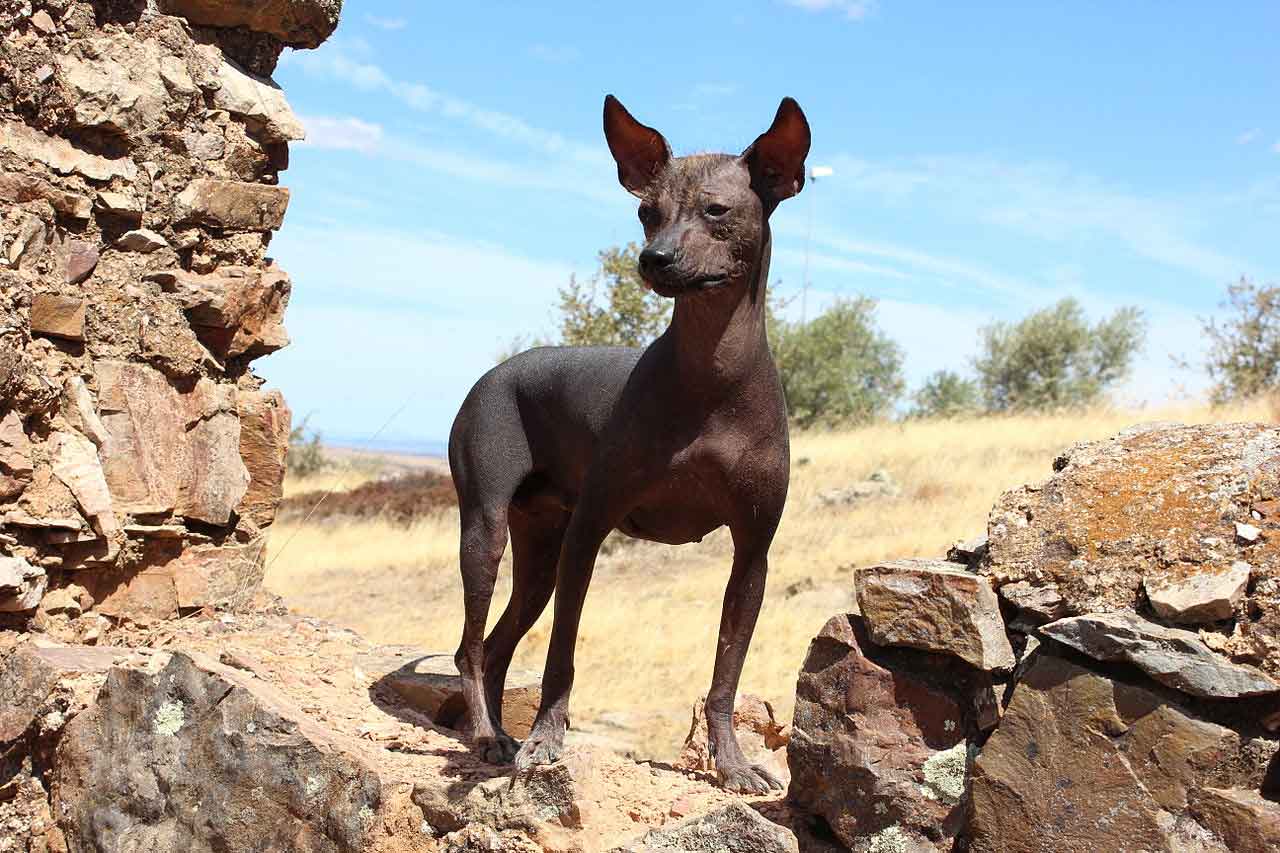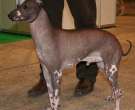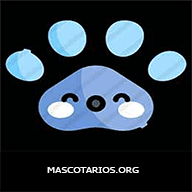Content |
|---|
History
The exact origin of the Peruvian Hairless Dog. But, their ancestors seem to be deeply rooted in Peru: Illustrations on the vessels of Moche culture, show hairless dogs already in the 750 AC. Later, these funny animals were reserved for the rich Incas, who took care not to mate them with other native dogs. It was also the Incas who prohibited the consumption of dog meat in the northern regions of Peru..
When the Spanish conquered the country, they found many naked dogs among the orchids of the Incas, so the Europeans called them “perros de las flores“. During the period of conquest, the breed was almost extinct, but some specimens survived in remote villages where the inhabitants valued them for the partly mythical qualities attributed to them: Because of its special appearance, four-legged creatures were said to have a healing effect on certain diseases, for example, bone and joint diseases.
In 1985, the world's largest dog breeding organization, the Federation Cynologique Internationale (FCI), recognized the Peruvian Hairless Dog as an independent race. So Today There Are Officially Three Naked Dog Breeds. Besides of Peruvian Hairless Dog, these are the Mexican Naked Dog, also known by the beautiful name of “Xoloitzcuintle“, and the Chinese Crested Dog. The three races are closely related to each other.
Physical characteristics
The name says it all: The most striking of the most Peruvian Hairless Dogs that's what's missing: the coat. But, the standard allows for some locks on the head and tail even in naked dogs without hair. Skin can be light or dark in different shades of color, smooth or white-spotted. But, not all naked dogs are naked, because there's a variant with hair: the so-called “Furry”, which are essential for breeding for health reasons. About a third of naked dogs belong to this group.
Since 2013 hairy variants can also be seen in canine exhibitions, since they have been added to the standard. Your hair should be short and soft, all colors are allowed. The Peruvian Hairless Dog reminiscent of greyhounds in their physique. This slender breed of dog has large erect ears that can rest back, an elegantly curved and hanging tail and an athletic complexion.
Naked dog lovers can enjoy three size variations:
– The small version has a shoulder height of 25 to 40 cm..
– The median 40 to 50 cm..
– The Greats Peruvian Hairless Dogs have between 50 and 65 height cm.
The weight varies according to 4 to 25 kg. Only a few Peruvian Hairless Dogs have a full denture, but these usually include all representatives of the furry variant.
Character and skills
The Peruvian Hairless Dog is a friendly and adaptable companion. He prefers to be with his human with the one who has a close relationship. It belongs to very sociable dogs. He likes to integrate into a family and quickly befriends other pets and children. It is said that many Peruvian Hairless Dogs protect fervently, especially the women and children of the herd. Here it is important to be careful when visiting children that the Peruvian interprets offensive situations for his protégé and rushes to help his little two-legged friend unnecessarily..
Vivacious and curious, is a wonderful companion for outdoor activities, but behaves calmly and relaxed inside. He especially likes to get comfortable on his owner's lap and enjoys closeness and warmth.. To strangers he is often distant and alert, but not aggressive.
Education
Like a dog of the original type, the Peruvian Hairless Dog it also provides original behavior in the man-animal relationship. That's why it makes sense in educational matters if you already have any experience with dogs. But, even ambitious beginners can successfully train a Peruvian Hairless Dog. Clear rules and consistency are, as in most dogs, the key to success.
The Peruvian Hairless Dog is a sensitive four-legged friend – hard you'll only get the opposite with it – will retire. Some Peruvian Hairless Dogs tend to get scared or fear new situations. So, it is especially important to train this dog extensively and at the right pace to different situations without overloading it.
Your breeder will be able to give you some advice when you buy a puppy. Whether on a train journey, on a trip to the city center or on a visit home, introduce your partner into these everyday situations since you're a puppy. Regular training at a canine school, preferably already with the young puppy in the form of playgroups for puppies, is highly recommended and also reinforces the social side of the Peruvian Hairless Dog.
Raising the “Peruvian Hairless Dog”
As already mentioned, during mating a special health feature should be taken into account: during breeding, the furry ones, that is to say, hairy representatives of the breed, should be crossed regularly. The reason for this is that the dominant allele of hairlessness can only lead to viable embryos in combination with a hair allele, that is to say, Heterozygosity. Homozygous hairless embryos are already reabsorbed in the uterus. As pure breeding for hairlessness is therefore not possible, hairless naked dogs also occur over and over again.
The Peruvian Hairless Dogs they usually have an incomplete denture, what doesn't usually restrict them. With the light-skinned specimens, especially at the beginning of summer, it's important to make sure they get used slowly in the sunlight, then tanning. Sun protection also makes sense, because otherwise dogs can develop severe sunburn, especially when they like to go to sunny places. Also in winter some specimens need protection from the weather in the form of a dog coat., because if they can't run, cool down quickly during normal ride. Smaller variants of the breed are more sensitive to this than larger ones.
One Peruvian Hairless Dog can reach an age of up to 15 years.
Care
With the naked representatives of the breed you can leave the comb with confidence. It also, has the great advantage that it can normally detect parasites in the skin of the Peruvian Hairless Dog immediately and apply appropriate antidotes – from tick tweezers to flea repellent. But, even the Peruvian Hairless Dog needs regular care. If required – some owners recommend once a week – wash it with a sponge and a mild dog shampoo. Some Peruvian Hairless Dogs tend to have dry skin, which can be remedied with soft moisturizers for fragrance-free babies or with olive or coconut oil. In summer, sunscreen is an indispensable tool for light-colored dogs. Cut the claws of your Peruvian Hairless Dog if they get too long and clean your four-legged friend's ears with a dog ear cleaner if necessary.
For sale “Peruvian Hairless Dog”
The Peruvian Hairless Dog are rare in Europe and therefore breeders are rare. Find the appropriate umbrella organizations in your country, that can help you in your search. In Germany, for example, el Club for Exotic Breed Dogs e.V. has a list of breeders, switzerland has a “Swiss Naked Dog Club of Latin America”, which is dedicated to the promotion of the two breeds of dogs: the Xoloitzcuintle and the Peruvian Hairless Dog. In these clubs and similar ones you can find information and contacts of ambitious breeders. Considering possible adoptions across national borders, consider what to consider when adopting puppies from abroad.
As a fan of naked dogs, you probably know the closely related races, the Xoloitzcuintle and the Chinese Crested Dog – perhaps one of these dogs could also be an option for you and is more likely to be found in your region. It also, openness to the other two races, as well as the crossings, it's usually a good idea if you want to give a home to a naked older dog. This usually requires some research. But in the meantime, keywords such as “naked dogs in distress” on the Internet promise successes that lead naked adult dogs to look for a new place to live. Try to find out as much as possible about the story of your potential new fourth-legged partner.
Characteristics "Peruvian Hairless Dog"
Coexistence is important that you have with your new friend. Before considering the acquisition of a dog of the breed "Peruvian Hairless Dog" you know certain factors. Not all breeds of dogs are apt to live in an apartment, you must take into account his character, their need for exercise, their interaction with other pets, their care and if you have small children, their level of tolerance towards them.
Training ?4.0 out of 5 stars (based on 30 reviews)
|
Suitability of the apartment ?3.0 out of 5 stars (based on 1 review)
|
Can be alone all day ?2.0 out of 5 stars (based on 1 review)
|
|---|---|---|
Suitable as a first dog ?3.0 out of 5 stars (based on 1 review)
|
Weight gain ?3.0 out of 5 stars (based on 1 review)
|
Health ?3.0 out of 5 stars (based on 1 review)
|
Intelligence ?3.0 out of 5 stars (based on 1 review)
|
Kindness with child ?3.0 out of 5 stars (based on 1 review)
|
Tendency to bite ?2.0 out of 5 stars (based on 1 review)
|
Tendency to bark ?3.0 out of 5 stars (based on 1 review)
|
Tendency to flee ?2.0 out of 5 stars (based on 1 review)
|
hair loss strength ?1.0 out of 5 stars (based on 1 review)
|
Suitable as a guard dog ?3.0 out of 5 stars (based on 1 review)
|
Joy ?3.0 out of 5 stars (based on 1 review)
|
Cat friendliness ?3.0 out of 5 stars (based on 1 review)
|
Power level ?3.0 out of 5 stars (based on 1 review)
|
Images "Peruvian Hairless Dog"
Photos:
1 – “Peruvian Hairless Dog” by Paradais Sphynx, CC BY-SA 3.0, via Wikimedia Commons
2 – “Peruvian Hairless Dog” by No machine-readable author provided. Manuel González Olaechea assumed (based on copyright claims)., CC BY-SA 3.0, via Wikimedia Commons
3 – “Peruvian Hairless Dog” by Carlos Adampol Galindo from DF, Mexico, CC BY-SA 2.0, via Wikimedia Commons
4 – “Peruvian Hairless Dog” by Marina Alonso Esparré, CC BY-SA 4.0, via Wikimedia Commons
5 – “Peruvian Hairless Dog” by Carlos Adampol Galindo from DF, Mexico, CC BY-SA 2.0, via Wikimedia Commons
6 – “Peruvian Hairless Dog” by Carlos Adampol Galindo from DF, Mexico, CC BY-SA 2.0, via Wikimedia Commons
7 – “Peruvian Hairless Dog” by Pleple2000, CC BY-SA 3.0, via Wikimedia Commons
Videos "Peruvian Hairless Dog"
|
|
|
|---|
Type and recognitions:
- FCI CLASSIFICATION: 310
- Group 5: Spitz and primitive types
- Section 6: Primitive type. Without working trial..
Federations:
- – FCI – Group 5: Spitz-type dogs and primitive type – Section 6: Primitive type. ⓘ
FCI breed standard "Peruvian Hairless Dog"
Alternative names:
1. Perro Sin Pelo de Perú, Inca Hairless Dog, Viringo, Peruvian Inca, Orchid, Calato, Peruvian Walking Dead dog, Dielmatian (English).
2. Chien nu Inca (French).
3. Peruanischen Nackthund (German).
4. Perro Sin Pelo del Perú, viram (Portuguese).
5. Perro calato, Perro chimo, Perro chimoc, Perro chimú, Perro de , orquídea peruano, Perro inca, Perro peruano, Perro peruano sin pelo, Perro pila, Perro sin pelo del Perú, Perro sin pelo peruano
Viringo (español).







